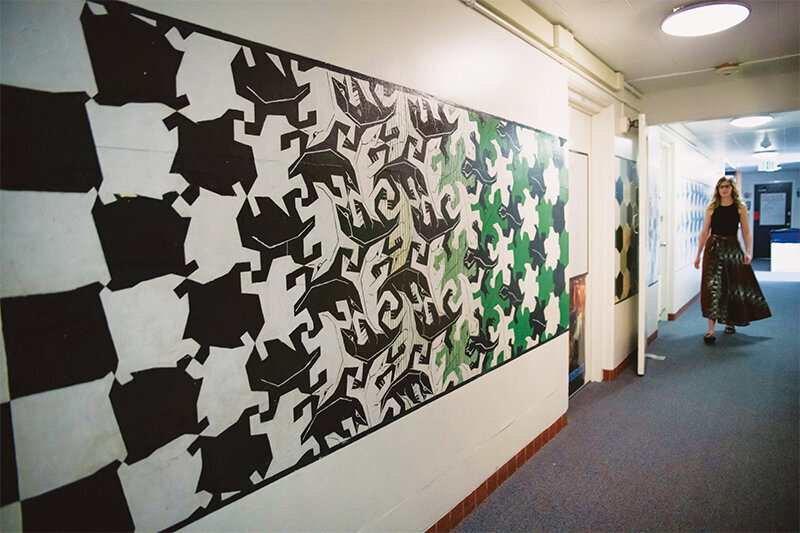Short Takes
Off the Wall
Of all the murals adorning the hallways of Ruddock House, which include a Monopoly board and a giant depiction of an astronaut, the copy of M.C. Escher’s woodcut Metamorphose is one of the most complex. Tom Berto (BS ’83) recalls the process of painting it, which began at the start of his junior year: “I bought a copy, mail-order, of the woodcut as a very long, rolled-up poster and enlarged it by a factor calculated to allow it to fit within the available length. Because it is such a long, long woodcut, it was ideal for a long hallway. At the beginning, about four people worked on it, but within a week or two, after just a few feet, the help tailed off, and it was just me. The pattern started out geometric and was easy to enlarge and ‘draft’ onto the wall with rulers, compass, and pencil, but it quickly became more complicated, and I eventually settled on laying out important reference points on the wall, projecting close-up Kodachrome slides onto the wall, and painting the projected image. I don’t think I got to the end of the first wall during my junior year, junior years being what they are at Caltech. In my senior year, my course load eased up, and so I was able to work on it more. I completed it in the last week or two before graduation. I think I spent about 230 hours on it. I painted myself into the mural: about 15 feet from the end there is a seaside village with a promenade, and I added myself, riding a bike. … I have had a long career as a mechanical engineer: at Hewlett-Packard, then Agilent, then Keysight Technologies. But the painting urge came out as a painting avocation that has been satisfying and durable, if not financially rewarding.”
See more of Tom Berto’s art
Balto: Portait of a Robot
Caltech senior Alexandra Bodrova fabricates custom parts for Balto.
Last summer, Balto, a robot designed and built by undergraduate and graduate students at Caltech in collaboration with robotics researchers at JPL, took to the field in the first phase of the Defense Advanced Research Projects Agency (DARPA) Subterranean (SubT) Challenge. This international competition advances technologies to autonomously map, navigate, and search underground environments. The Caltech-JPL team took second place in that contest and then, in February, claimed first place in the Urban Circuit phase of the competition. Balto, named after a famous rescue dog, was built atop a commercial radio control car and is one of a fleet of robots designed for the competition. Smaller, lighter, and faster than its peers, Balto is deployed primarily as a ground-based scout.
History Located
As part of the Tianqiao and Chrissy Chen Neuroscience Research Building construction project, the Wilson Court bungalows, originally located on the southeast corner of Del Mar Boulevard and Wilson Avenue, were transported in 2018 two blocks away to the northeast corner of Catalina Avenue and San Pasqual Street. Late in 2019, restoration of the exteriors of the historic bungalow court was completed. The Spanish Colonial Revival–style court was originally built in 1923, with five of the buildings arranged around a central landscaped courtyard. Two additional structures were built to one side of the main court, an unusual feature for a bungalow court and one that adds to its historical significance. As part of the relocation project, Caltech repaired and restored the terracotta tile parapets, lime plaster exterior walls, wooden window trim, French entry doors with arched transoms, and other historical features.
Quake Map
A decade ago, Caltech earthquake scientists and engineers rolled out a network of low-cost, easy-to-install seismometers. With around 800 sensors now in the L.A. area, the Community Seismic Network (CSN) recently expanded westward with another hundred, thanks to new funding from the Conrad N. Hilton Foundation and Computers & Structures, Inc.
Most of the sensors are situated on L.A. Unified School District campuses, which brings distinct advantages, says Monica Kohler (PhD ’95), a research professor of mechanical and civil engineering. “When an earthquake happens and the waves propagate, we like to see this very coherent picture of what the wave is doing as it travels across the L.A. Basin. And having all of these stations roughly equidistant, at half a kilometer spacing, gives us that information.”
In addition to the LAUSD sensors, the network also includes a 52-story tower in downtown L.A. and several other mid- and high-rise buildings with instruments on every floor. The network provided highly granular and detailed information about how the Ridgecrest earthquake series shook the Los Angeles area and how different buildings responded to the quakes. “For our next batch of stations, we want to focus on the area around West Los Angeles,” says Kohler, “to capture what the effects would be on those high-rises.”






